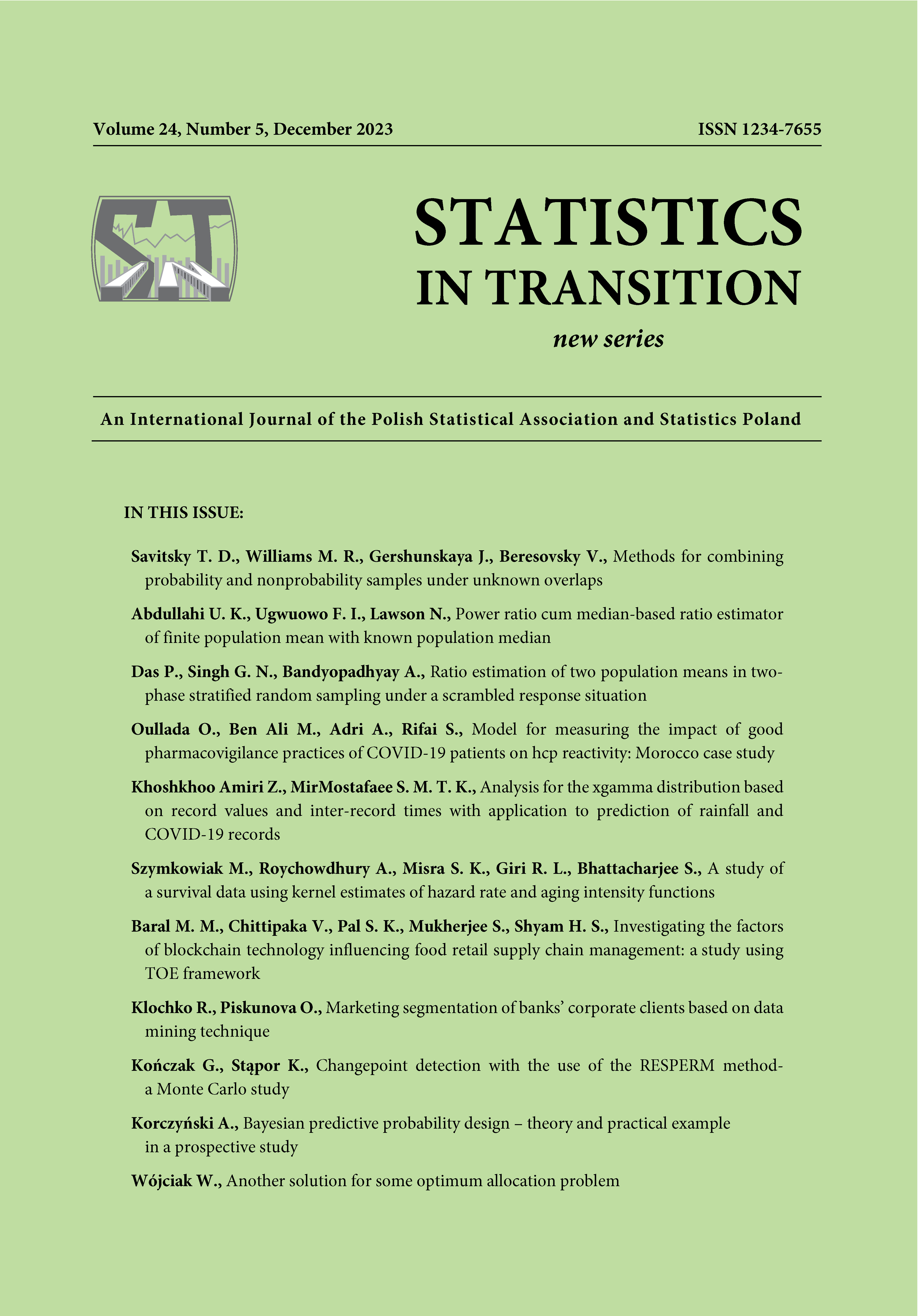ARTICLE
ABSTRACT
Analyzing survival (life-testing) data and drawing inferences about them is a part of engineering and health sciences. So far, various statistical tools, e.g., survival (reliability) function (s f ), probability density function (pd f ), and hazard rate function (HR) were available among decision-making scientists to handle time-to-event data (complete or censored). But because functions (pd f ) estimators were interval (window) based, they mostly gave qualitative ideas having pictorial representation resembling step functions, ordinate remain constant when abscissa vary over an interval, thereby giving incomplete information. However, it can be sorted out with the use of kernel estimates of the above mentioned functions, resulting into smooth estimators. Moreover, the metric based on aging intensity function (AI) gives an alternative way of studying lifetime or clinical datasets as it is a quantitative measure (not interval-based), thereby depicting a broader view of a given data. In our study, we primarily focus on AI and HR functions estimated using four different kernels. We apply them to a case study of patients with primary malignant tumors of sternum (cf. Daniel and Cross, 2014) with the right-censored data. Our result shows that kernel estimates of HR and AI functions for patients with high grade tumor (HGT) are higher than for patients with low grade tumor (LGT), as expected. Thus, the study opens up a new direction for applying AI and HR functions in health sciences and engineering studies.
KEYWORDS
hazard rate, aging intensity function, kernels, survival analysis, cancer statistics, clinical datasets.
REFERENCES
D’Agostino, R. B., Stephens, M. A., (1986). Goodness-of-Fit Techniques, New York, NY, USA: Marcel Dekker.
Bhattacharjee, S., Mohanty, I., Szymkowiak, M. and Nanda, A. K., (2022). Properties of aging functions and their means. Communications in Statistics: Simulation and Computation, https://doi.org/10.1080/03610918.2022.2141257
Bhattacharjee, S., Nanda, A. K., and Misra, S. K., (2013a). Reliability analysis using aging intensity function. Statistics and Probability Letters, 83 (5), pp. 1364–1371.
Bhattacharjee, S., Nanda, A. K., and Misra, S. K., (2013b). Inequalities involving expectations to characterize distributions. Statistics and Probability Letters, 83 (9), pp. 2113–2118.
Bowman, A. W., Azzalini, A., (1997). Applied smoothing techniques for data analysis, New York: Oxford University Press Inc.
Daniel, W. W., Cross, C. L., (2014). Biostatistics: Basic Concepts and Methodology for the Health Sciences, Tenth Edition, Wiley India Pvt Ltd.
DiNardo, J., Tobias, J., (2001). Nonparametric density and regression estimation, The Journal of Economic Perspectives, 15, pp. 11–28.
Emmerson, J., Brown, J. M., (2021). Understanding Survival Analysis in Clinical Trials, Clinical Oncology, 33 (1), pp. 12–14.
Giri, R. L., Nanda, A. K., Dasgupta, M., Misra, S. K., and Bhattacharjee, S., (2023). On aging intensity function of some Weibull models. Communications in Statistics-Theory and Methods, 52(01), pp. 227-262. DOI: 10.1080/03610926.2021.1910845
Jiang, R., Ji, P., and Xiao, X., (2003). Aging property of univariate failure rate models. Reliability Engineering and System Safety, 79, pp. 113–116.
Klein, J. P., Moeschberger, M. L., (2003). Survival Analysis Techniques for Censored and Truncated Data: Statistics for Biology and Health, Series Editors: Dietz, K., Gail, M., Krickeberg, K., Samet, J,. and Tsiatis, A., 2nd Edition, Springer-Verlag New York, Inc.
Martini, N., Huvos, A. G., Burt, M. E., Heelan, R. T., Bains, M. S., Mccrmack, P. M., Rusch, V. M., Weber, M., Downey, R. J., and Ginsberg, R. J., (1996). Predictions of Survival in Malignant Tumors of the Sternum, Journal of Thoracic and Cardiovascular Surgery, 111, pp. 96–106.
Miladinovic, B., (2008). Kernel density estimation of reliability with applications to extreme value distribution, Graduate Theses and Dissertations submitted in University of South Florida, http://scholarcommons.usf.edu/etd/408.
Misra, S. K., Bhattacharjee, S., (2016). Properties of Weibull models, Far East Journal of Mathematical Sciences, 100(12), pp. 1965–1979.
Misra, S. K., Bhattacharjee, S., (2018). A case study of aging intensity function on censored data, Alexendria Engineering Journal, 57, pp. 3931–3952.
Nanda, A. K., Bhattacharjee, S., and Alam, S. S., (2006). Properties of proportional mean residual life model, Statistics and Probability Letters, 76 (9), pp. 880–890.
Nanda, A. K., Bhattacharjee, S., and Alam, S. S., (2007). Properties of aging intensity function, Statistics and Probability Letters, 77, pp. 365–373.
Nanda, A. K., Bhattacharjee, S., and Balakrishnan, N., (2010). Mean residual life fuction, associated orderings and properties, IEEE Transactions on Reliability, 59(1), pp. 55– 65.
Nayak, A., Kumar, S., Singh, S. P., Bhattacharyya A., Dixit A., and Roychowdhury A., (2021). Oncogenic potential of ATAD2 in stomach cancer and insights into the proteinprotein interactions at its AAA+ATPase domain and bromodomain, Journal of Biomolecular Structure and Dynamics, pp. 1–17.
Rosen, K., Prasad, V., Chen, E. Y., (2020). Censored patients in Kaplan-Meier plots of cancer drugs: An empirical analysis of data sharing, European Journal of Cancer, 141, pp. 152-161. doi: 10.1016/j.ejca.2020.09.031.
Shaked, M., Shanthikumar, J. G., (2007). Stochastic Orders (Springer Series in Statistics). San Diego.
Szymkowiak, M., (2018). Characterizations of Distributions Through Aging Intensity, IEEE Transactions on Reliability, 67, pp. 446–458.
Swain, P., Bhattacharjee S. and Misra, S. K., (2021). A Case Study to Analyze Ageing Phenomenon in Reliability Theory, Reliability: Theory and Applications, 16(4 (65)), pp. 275–285.
Szymkowiak, M., (2019). Measures of aging tendency, Journal of Applied Probability, 56(2), pp. 358–383.
Szymkowiak, M., (2020). Lifetime analysis by aging intensity functions studies in systems. In Decision and Control. Series editor. Vol. 196. Switzerland: Springer Nature.
Gamrot, W., (2012). Estimation of Finite Population Kurtosis under Two-Phase Sampling for Nonresponse. Statistical Papers, 53, pp. 887–894.
Gamrot, W., (2013). Maximum Likelihood Estimation for Ordered Expectations of Correlated Binary Variables. Statistical Papers, 54, pp. 727–739.
Gamrot, W., (2012). Estimation of Finite Population Kurtosis under Two-Phase Sampling for Nonresponse. Statistical Papers, 53, pp. 887–894.
Gamrot, W., (2013). Maximum Likelihood Estimation for Ordered Expectations of Correlated Binary Variables. Statistical Papers, 54, pp. 727–739.
Särndal, C-E., Swensson, B., Wretman, J., (1992). Model Assisted Survey Sampling, New York: Springer.
